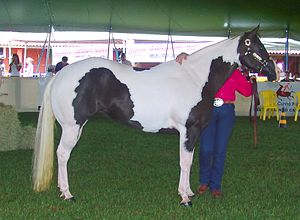Pinto horse
A Pinto horse is a spotted horse. They are not a breed, but a coat color. In fact, any horse breed can be a Pinto as long as they have patches of white or another color. Pintos are often confused with Paints, a horse breed. They look very similar. The difference is that a Paint is a breed, and a Pinto is a coat color that can be on any breed, including Paints.

History
changePintos are so old that they were found in tombs in Ancient Egypt dating back to 4 B.C.[1] In the 16th century Cortez brought thousands to the New World. Some of them were set free, and Native Americans caught them. The Native Americans liked them for their toughness and their color. Their color blended in with the environment and made a natural camouflage. They were known to make great war horses.[2] Their name came from the Spanish word pintado, which means “painted”.
Color
changePintos have pink skin, blue eyes, and white or multicolored hooves. They can be either a white horse with colored patches, or a colored horse with white patches.[3] It has been said that no two Pintos are exactly alike.
Patterns
changePintos have 3 different patterns:
Type
changePintos come in 4 different types:[3]
- Stock: A Western horse, usually a Quarter Horse or a Paint
- Hunter: An English horse, usually a Thoroughbred or a European Warmblood
- Pleasure: Usually an Arabian, Andalusian, or a Morgan
- Saddle: A gaited horse, usually a Saddlebred, Hackney, or a Tennessee Walker
Size
changePintos come in 4 different sizes:[3]
- Miniature: usually about 34 inches.
- Miniature B: usually about 34-38 inches.
- Pony: usually about 38-56 inches.
- Horse: 56 inches and up.
Related pages
changeReferences
change- ↑ "National Pinto Horse Registry", http://www.pintohorseregistry.com/TheBreed.html Archived 2010-02-03 at the Wayback Machine, (Date accessed: Feb 10, 2010)
- ↑ "Horse Breed Directory: Pinto", http://animal.discovery.com/guides/horses/breeds/pinto.html, (Date accessed: Feb 10, 2010)
- ↑ 3.0 3.1 3.2 "About The Pinto", http://www.pinto.org/about_pinto.html[permanent dead link], (Date accessed: Feb 10, 2010)